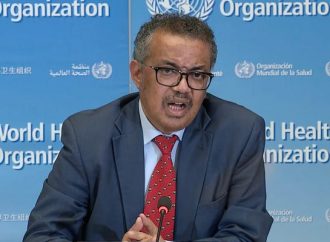admin
- Home
- admin
Author's Posts

High-End Bikini Designer Launches New Fashion Masks to Help People Who Need it the Most0
- SHOPPING
- April 18, 2020
From designing a bikini for Kylie Jenner to making masks for healthcare workers who need it the most.
READ MORE
What Anybody Who’s Made Wine Their Quarantine Buddy Should Know0
Much of the U.S. has been instructed to stay at home for at least several weeks to prevent the spread of the COVID-19 virus. In consequence, many of the businesses are now closed, grinding the economy to a gut-wrenching standstill and forcing millions into unemployment. With so much time to kill, people are seeking more
READ MORE

Netflix has surged more than 20% this week to a record high amid Wall Street optimism0
- TV & MOVIES
- April 16, 2020
Netflix
Netflix shares surged to a record high of $449 per share on Thursday after gaining roughly 20% through the week on strong demand and praise from analysts.
Shares jumped more than 7% on Monday despite a broad market slide, while Tuesday’s and Wednesday’s sessions saw gains of 4.2% and 3.2%.
A price-target boost from Goldman Sachs helped drive shares as much as 5.3% higher in Thursday trading.
The streaming giant’s popular new shows like “Tiger King” and strong demand during stay-at-home orders set it up for strong subscriber growth “both in the immediate and long term,” the team of analysts wrote.
Watch Netflix trade live here.
As most stocks have only started clawing their way to pre-pandemic highs, Netflix recently joined the small club of stocks to soar amid worsening economic conditions.
The streaming company traded as much as 5.3% higher on Thursday, to a record $449 per share, adding to an already momentous weekly streak. Monday saw the stock gain more than 7% despite a broad market downturn, and a mix of investor optimism and praise from analysts fueled additional gains in the sessions since.
Tuesday and Wednesday saw shares jump about 4.2% and 3.2% as market rebounds and selective buying aided firms best positioned to grow amid coronavirus lockdowns.Amazon similarly posted multiple record highs through the week as demand for online shopping skyrockets.
Netflix traded 3.4% higher, to $441.31 per share, at 12:15 p.m. ET on Thursday. The entertainment giant is up roughly 38% year-to-date, compared with the S&P 500’s 13% slump in 2020.
Read more: ‘I’ve gone to cash’: Mark Cuban outlines his coronavirus investing strategy ahead of another ‘leg down’ in markets — and shares why now is the time to buy real estate
Goldman Sachs is the latest firm to recommend buying shares. The bank’s analysts boosted their 12-month price target for Netflix to $490 on Thursday, naming it one of the few businesses seeing stable demand during widespread social distancing. Popular new programming including “Tiger King” and a third season of “Ozark” further lifted shares, the bank said.
“Content additions to the platform, combined with the value of Netflix’s library to those staying home during the COVID-19 crisis, drove this outperformance, more than offsetting the lingering impact of last year’s price increase and growing competition in [streaming],” the team led by Heath Terry wrote in a note.Read more: Chris Davis is so good at picking stocks he made clients $1 billion on a single trade. He breaks down 3 stocks poised to deliver as coronavirus causes market mayhem
The health crisis is also accelerating the years-long shift from traditional content outlets like TV and movie theaters to streaming services, the analysts said. Netflix’s position as the oldest and most established firm in the segment sets it up for boosted subscriber growth “both in the immediate and long term,” Goldman said.
The company is scheduled to announce its first-quarter results after the market closes on Tuesday.
Now read more markets coverage from Markets Insider and Business Insider:
Consumer sentiment dives to its lowest point since before President Trump’s election on escalating pandemic damageUS housing starts plunged the most since 1984 in March as coronavirus rocked the market
READ MORE
Bank of America breaks down how to build the perfect post-coronavirus portfolio — one designed to recover losses and get ahead of an eventual economic recovery
Markets Insider
Trump claims the WHO took part in ‘covering up the spread of the coronavirus.’ What really happened?0
- NEWS
- April 16, 2020
President Donald Trump announced this week that he plans to halt US funding for the World Health Organization.
During a White House press conference on Tuesday, Trump blamed the WHO for “severely mismanaging and covering up the spread of the coronavirus,” and said the US would end its annual contribution — which was $418 million in 2018 — to the organization.
The allegations stem from recent reports that show China has not been wholly truthful about its number of cases and deaths, and that officials there hid the fact that the virus could spread person-to-person for six days.
But the World Health Organization used information that Chinese officials relayed to it to inform public-health policy recommendations.
“The WHO willingly took China’s assurances to face value, and they took it just at face value and defended the actions of the Chinese government, even praising China for its so-called transparency,” Trump said on Tuesday.Conflicting information about the beginning of the outbreak
Authorities in Wuhan first informed the WHO about 41 cases of an unknown, pneumonialike illness on December 31. They said the infections appeared to be linked to a local wet market. The WHO set up an incident management team to deal with the outbreak the following day.
Recent studies, however, have revealed that those late-December cases were not the first in Wuhan.A woman walks in front of the closed Huanan wholesale seafood market, where health authorities say a man who died from a respiratory illness had purchased goods from, in the city of Wuhan, Hubei province, on January 12, 2020. – A 61-year-old man has become the first person to die in China from a respiratory illness believed caused by a new virus from the same family as SARS, which claimed hundreds of lives more than a decade ago, authorities said. NOEL CELIS/AFP via Getty Images
A study published last week suggested that the coronavirus was spreading in the local community by early January, and research in The Lancet showed that the first person to test positive for the coronavirus was likely exposed to it on December 1, then showed symptoms on December 8.
Such findings don’t align with China’s official narrative, but it’s not yet clear when Chinese officials actually first realized a new disease was spreading.
The WHO has praised China’s outbreak responseWorld Health Organization Director General Tedros Adhanom Ghebreyesus during a virtual news briefing on COVID-19 from WHO headquarters in Geneva on April 6, 2020. AFP via Getty Images
On April 7, before announcing he’d cut WHO funding, Trump accused the organization of being “very China-centric.”The WHO doesn’t have much to gain financially by aligning with China more than other countries — China’s annual contribution is $40 million, less than 1% of the organization’s annual budget. But the WHO has nonetheless applauded China’s response to the coronavirus.
WHO Director-General Tedros Adhanom Ghebreyesus said on January 29 that China’s actions, like locking down Wuhan, “helped prevent the spread of coronavirus to other countries.” And a WHO envoy sent to China in February reported that the rest of the world was “not ready” to fight COVID-19 the way China did.
This praise might have to do with the marked difference between China’s response to COVID-19 and the strategy it pursued during SARS coronavirus outbreak in 2002. The Chinese government didn’t inform the WHO about SARS until February 14, 2003 — 88 days after the first reported case. According to The Sydney Morning Herald, doctors in Beijing were ordered by authorities to hide SARS patients from WHO officials during inspections.
The WHO could have been more skeptical about Chinese data
Michael Ryan, the executive director of the WHO’s health emergencies program, said on January 29 that the organization had “seen no obvious lack of transparency” from China. Trump also tweeted praise for China’s transparency in late January.
But recently, experts have raised concerns about the accuracy of China’s reported numbers of cases and deaths — especially during the first stages of the outbreak — as well as about when Chinese officials realized the virus could jump between people.A memo between top Chinese officials, obtained by The Associated Press, revealed that Chinese officials knew people could transmit the coronavirus to each other by January 14, but didn’t tell the world (or the WHO) until January 20.
In those six intervening days, China publicly said there was no evidence of human-to-human transmission. The WHO relied on that information to direct policy and advise other countries, tweeting that “preliminary investigations conducted by the Chinese authorities have found no clear evidence of human-to-human transmission.”A worker collects a test swab from a construction worker in Wuhan, China, April 7, 2020. China Daily via Reuters
Although China kept this information from the WHO as much as it did from the rest of the world, Jamie Metzl, a WHO expert and former member of the US National Security Council, said the organization could have been quicker to call out China’s shortcomings.
The WHO “could have done an earlier and better job of highlighting China’s failure to permit access to WHO experts and share critical information and of sounding the alarm,” he said in a statement shared with Business Insider.
Cutting funding to the WHO undermines the pandemic response
The US is by far the largest funder of the WHO — its 2018 contribution was equal to about 9.5% of the agency’s budget for the 2018-19 year. Of the 41 member states that voluntarily contribute annual funds, the US gives the most by a factor of nearly four.“Like many other organizations and states, the WHO made mistakes during this crisis that must all be reviewed carefully, thoughtfully, and urgently,” Metzl said. But, he added, “cutting off US funding to the World Health Organization in the middle of the worst pandemic in a century is the height of self-defeating lunacy.”
Pallets of surgical gowns are unloaded from an international cargo plane in Miami, Florida, on March 31, 2020. Reuters
READ MORE
Jack Chow, a former WHO assistant director-general, previously told Business Insider that cutting WHO funding would be a “profound mistake.”
He said such defunding could mean “the pandemic could last for many more months, even years, longer, and could even become permanent among human populations.”
Something is loading.





